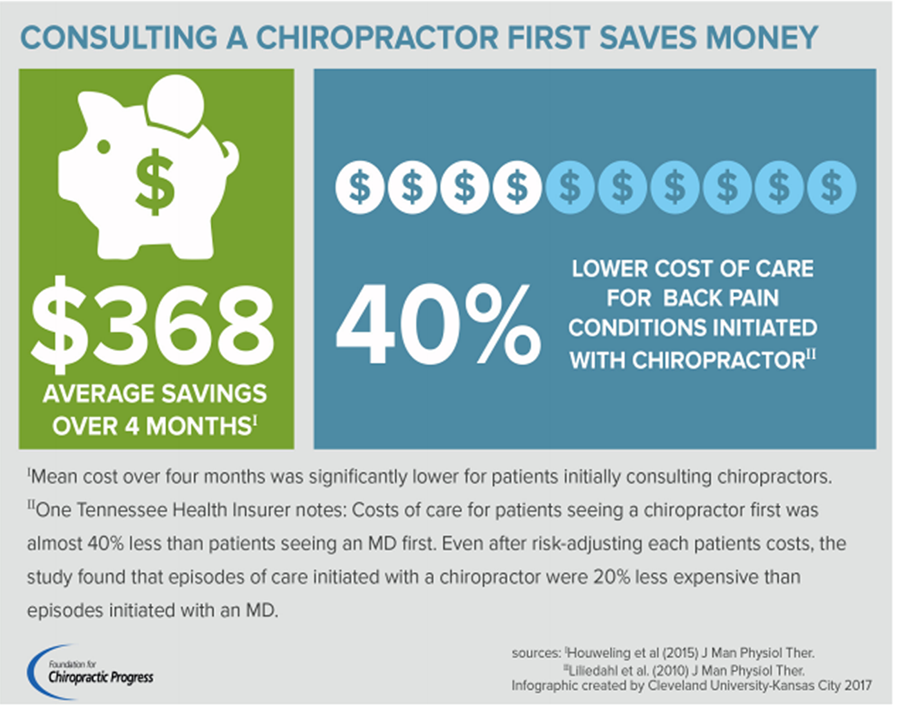Three Patterns of Spinal Manipulative Therapy for Back Pain and Their Association With Imaging Studies, Injection Procedures, and Surgery: A Cohort Study of Insurance Claims
SOURCE: J Manipulative Physiol Ther 2021 (Nov); 44 (9): 683–689
Brian R. Anderson, DC, MPH, MS, PhD, Steve W. McClellan, MS
Palmer Center for Chiropractic Research,
Palmer College of Chiropractic,
Davenport, IA.

FROM:
Houweling, JMPT 2015 Liliedahl, JMPT 2010
Objective: The purpose of this study was to evaluate the relationship between procedures and care patterns in back pain episodes by analyzing health insurance claims.
Methods: We performed a retrospective cohort study of insurance claims data from a single Fortune 500 company. The 3 care patterns we analyzed were initial spinal manipulative therapy, delayed spinal manipulative therapy, and no spinal manipulative therapy. The 3 procedures analyzed were imaging studies, injection procedures, and back surgery. We considered “escalated care” to be any claims with diagnostic imaging, injection procedures, or back surgery. Modified-Poisson regression modeling was used to determine relative risk of escalated care.
Results: There were 83,025 claims that were categorized into 10 372 unique patient first episodes. Spinal manipulative therapy was present in 2,943 episodes (28%). Initial spinal manipulation was present in 2,519 episodes (24%), delayed spinal manipulation was present in 424 episodes (4%), and 7,429 (72%) had no evidence of spinal manipulative therapy. The estimated relative risk, adjusted for age, sex, and risk score, for care escalation (eg, imaging, injections, or surgery) was 0.70 (95% confidence interval 0.65–0.75, P < .001) for initial spinal manipulation and 1.22 (95% confidence interval 1.10–1.35, P < .001) for delayed spinal manipulation with no spinal manipulation used as the reference group.
There is more like this @ our:LOW BACK PAIN Section and the:
Conclusion: For claims associated with initial episodes of back pain, initial spinal manipulative therapy was associated with an approximately 30% decrease in the risk of imaging studies, injection procedures, or back surgery compared with no spinal manipulative therapy. The risk of imaging studies, injection procedures, or back surgery in episodes in the delayed spinal manipulative therapy group was higher than those without spinal manipulative therapy.
Keywords: Chiropractic; Injections; Low Back Pain; Orthopedic Surgery; Radiology; Spinal Manipulation; Therapeutics.
From the FULL TEXT Article:
Introduction
Back pain has been the leading cause of disability since 1990. [1] The lifetime prevalence of this condition is estimated at 60% to 70% in industrialized countries. [2] In the United States, back pain treatment costs are estimated at $8000 per person per year, totaling approximately $87 billion per year, or 2.5% of the gross domestic product. [3]
Approximately 18% of Americans report visiting a healthcare practitioner in the previous 12 months for a back pain related complaint, with general practitioners and chiropractors accounting for the greatest number of visits. [4] The American College of Physicians treatment guidelines for the management of acute, subacute and chronic back pain advocate for nonpharmaceutical treatments first. [5] However, the use of opioid medications, injection procedures, and surgeries for back pain have increased exponentially since 2000. [6–9] A recent study [10] found that primary care referrals for nonpharmaceutical care were relatively common for chronic back pain, but nonexistent for acute back pain, suggesting that recommended treatments are being underutilized. It has been suggested that escalating costs may be associated with overuse of low-value care (eg, imaging, injections, and back surgery) and underuse of high-value care. [2]
Given the extreme and growing costs associated the management of back pain, treatment strategies that avoid care escalation are increasingly relevant. Using imaging as an example, it has been estimated in the United States that 60% of lumbar MRI studies and 40% of lumbar radiography studies are inappropriate, which represents nearly $1 billion that could be saved. [11] Lower rates of low back surgery and advanced imaging procedures have been associated with chiropractic users as compared with other provider types. [12]






Leave A Comment